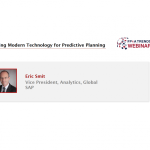The volume of data is so large and complex that forecasts are often unpredictable: the world...
 This series of eight blogs is intended for those considering a transition to “intelligent financial planning and analysis” – essentially, modernising solutions and systems to support a dynamic approach to analytics. Here, we’ll examine the technologies on the horizon that will support an intelligent FP&A solution.
This series of eight blogs is intended for those considering a transition to “intelligent financial planning and analysis” – essentially, modernising solutions and systems to support a dynamic approach to analytics. Here, we’ll examine the technologies on the horizon that will support an intelligent FP&A solution.
There are many terms connected with FP&A, such as “unstructured analysis,” “predictive analytics,” and “machine learning". Often very little detail on how they can be used in everyday life. Sure, there is an odd example, such as how the sales of one product in a supermarket are related to another based on their location. But what do these technologies actually do, and how can they help management in today’s fast-moving, complex business environment?
Perhaps the best place to start is by considering the progression in analytics beyond reporting and seeing the reasons why this has occurred. The following capabilities can be labelled as artificial intelligence (AI), as they try to mimic the behaviour of a person in using the data to predict or make changes in the future based on historical data.
Trending
This first capability has been around for many years, but typically within a dedicated statistical package. More recently, trending analysis has become part of the toolset available within most analysis systems under the name “predictive analytics.” It uses statistical techniques to detect patterns in the data of single variable overtime to produce a time-based formula that fits the series. This is then used to derive future series along with a degree of confidence about the accuracy of predicted numbers.
Correlation
This following capability recognises that practically all variables are influenced by other measures, whether they be actions or assumptions about the business environment. These linkages can be deduced mathematically using a technique called regression analysis. There are two types of variables: a dependent variable, which is the main factor that we are trying to predict, and independent variables, which are the factors we suspect have an impact on the dependent variable. This analysis produces a formula that can be used to predict future results of the dependent variable by entering values (or using the trends created above) for the independent variables.
Dynamic correlation
In this next stage of progression, the analytic system constantly refines its mathematical model of past results and doesn’t require the user to make changes to the rules governing predictions. This is the basis of machine learning, where the constant supply of data and results allows the model to learn from historical relationships and trends in the data.
Automated management processes
This final stage links results (or, more accurately, exceptions) to the management process itself. If any exception is spotted, the system can automatically trigger a response such as requiring more detail on the exception or causing a partial re-plan of the affected areas. This, in turn, moves organisations away from annual planning and budgeting to a process that is triggered by predicted exceptions.
Data models
In the past, all of the above capabilities required data to be stored in some form of model that had a defined structure. This would be as a series of relational database tables, a multidimensional database, or a combination of both.
Today, there is another option where data is not kept in a predefined model or organised in a structured manner, such as tables that have defined fields and records. A good example is Internet search engines that are able to produce analyses from the web that have no regular structure.
It’s still early days with this technology as far as FP&A is concerned. But it promises to speed up analyses as the data sources themselves, both internal and external to the organisation, become part of the model.
Limitations
The limiting factor of all these technologies is the data itself. They all rely on data being accurate and complete. They also rely on the fact that the world is rational and that people make decisions based on sound logic. But despite this, these tools are a powerful ally for management as they seek to understand the past and how it may affect the future.
The article was first published in the D!gitalist Magazine
Subscribe to
FP&A Trends Digest

We will regularly update you on the latest trends and developments in FP&A. Take the opportunity to have articles written by finance thought leaders delivered directly to your inbox; watch compelling webinars; connect with like-minded professionals; and become a part of our global community.






